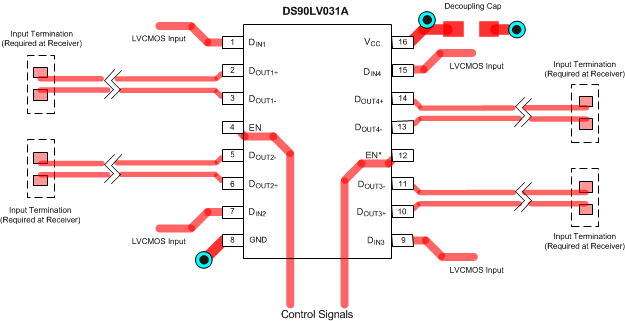SNLS020D July 1999 – August 2016 DS90LV031A
PRODUCTION DATA.
- 1 Features
- 2 Applications
- 3 Description
- 4 Revision History
- 5 Pin Configuration and Functions
- 6 Specifications
- 7 Parameter Measurement Information
- 8 Detailed Description
- 9 Application and Implementation
- 10Power Supply Recommendations
- 11Layout
- 12Device and Documentation Support
- 13Mechanical, Packaging, and Orderable Information
Package Options
Mechanical Data (Package|Pins)
Thermal pad, mechanical data (Package|Pins)
Orderable Information
11 Layout
11.1 Layout Guidelines
- Use at least 4 PCB layers (top to bottom): LVDS signals, ground, power, and TTL signals.
- Isolate TTL signals from LVDS signals, otherwise the TTL may couple onto the LVDS lines. It is best to put TTL and LVDS signals on different layers which are isolated by power or ground plane(s).
- Keep drivers and receivers as close to the (LVDS port side) connectors as possible.
11.1.1 Power Decoupling Recommendations
Bypass capacitors must be used on power pins. High frequency ceramic (surface-mount recommended) 0.1-µF in parallel with 0.01-µF, in parallel with 0.001-µF at the power supply pin as well as scattered capacitors over the printed-circuit board. Multiple vias must be used to connect the decoupling capacitors to the power planes. A 10‑µF, 35-V (or greater) solid tantalum capacitor must be connected at the power entry point on the printed-circuit board.
11.1.2 Differential Traces
Use controlled impedance traces which match the differential impedance of your transmission medium (that is, cable) and termination resistor. Run the differential pair trace lines as close together as possible as soon as they leave the IC (stubs must be < 10 mm long). This helps eliminate reflections and ensure noise is coupled as common-mode. Lab experiments show that differential signals which are 1 mm apart radiate far less noise than traces 3 mm apart because magnetic field cancellation is greater with the closer traces. Plus, noise induced on the differential lines is much more likely to appear as common-mode which is rejected by the receiver.
Match electrical lengths between traces to reduce skew. Skew between the signals of a pair means a phase difference between signals which destroys the magnetic field cancellation benefits of differential signals and results in EMI. Note the velocity of propagation, v = c/Er where c (the speed of light) = 0.2997 mm/ps or 0.0118 in/ps. Do not rely solely on the auto-route function for differential traces. Carefully review dimensions to match differential impedance and provide isolation for the differential lines. Minimize the number of vias and other discontinuities on the line.
Avoid 90° turns (these cause impedance discontinuities). Use arcs or 45° bevels.
Within a pair of traces, the distance between the two traces must be minimized to maintain common-mode rejection of the receivers. On the printed-circuit board, this distance must remain constant to avoid discontinuities in differential impedance. Minor violations at connection points are allowable.
11.1.3 Termination
Use a resistor which best matches the differential impedance of your transmission line. The resistor must be between 90 Ω and 130 Ω. Remember that the current mode outputs need the termination resistor to generate the differential voltage. LVDS will not work without resistor termination. Typically, connect a single resistor across the pair at the receiver end.
Surface-mount 1% to 2% resistors are best. PCB stubs, component lead, and the distance from the termination to the receiver inputs must be minimized. The distance between the termination resistor and the receiver must be < 10 mm (12 mm maximum).
11.2 Layout Example
 Figure 12. DS90LV031A Example Layout
Figure 12. DS90LV031A Example Layout